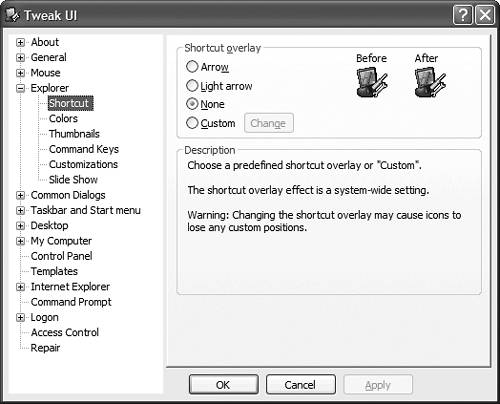Even More Personalization with Tweak UI Now it's time for me to let you in on one of my favorite Windows utilities. Tweak UI for Windows XP is a "power toy" from Microsoft that lets you further customize your desktop beyond what Windows XP normally lets you do. Microsoft says that Tweak UI is for so-called power users, but I think anyone reading this book will find it indispensable. Even though it's developed by Microsoft engineers, Tweak UI isn't included with Windows XP. Instead, you have to download it from Microsoft's Web site and install it separately. (You can download Tweak UI and other power toys from this page: www.microsoft.com/windowsxp/downloads/powertoys/xppowertoys.mspx.) Tweak UI for Windows XP lets you customize a variety of system settings that aren't otherwise accessible in Windows XP. To launch the utility, click the Start button and select All Programs, Accessories. Power Toys for Windows XP, Tweak UI. From here you can access a variety of Windows settings by clicking the appropriate parameter in the left-hand pane, as shown in Figure 2.26. Table 2.4 describes what you'll find. Figure 2.26. Tweaking Windows XP with Tweak UI. 
Table 2.4. Tweak UI SettingsSetting | Description |
|---|
About | Provides tips on how to use Tweak UI, as well as access to the Group Policy Editor (in Windows XP Professional Edition). | General | Turns on or off various Windows effects (such as window animation and smooth scrolling). Also prevents applications from stealing focus. | Mouse | Calibrates your mouse's speed and double-clicking and dragging sensitivity. You can also choose to have whichever window the mouse is over be your active window (the Activation Follows Mouse option), and select how you use your mouse wheel for scrolling. | Explorer | Changes the way shortcuts are displayed on the desktop (with small arrows, large arrows, no arrows, or a custom icon), turns on or off the "Shortcut to" prefix on new shortcuts, programs shortcut command keys, and lets you configure slideshows in picture folders. | Common Dialogs | Turns on or off various universal dialog box settings, as well as lets you customize Windows XP's Places Bar. | Taskbar and Start menu | Enables customization of the Start menu, as well as controlling various settings for the taskbar. | Desktop | Determines which standard system icons are displayed on your desktop. This is the way to get rid of pre-installed icons that you can't delete normally. | My Computer | Determines which drives are displayed in the My Computer window, as well as the location of special Windows folders. This is also where you can turn on or off Windows' AutoPlay feature. | Control Panel | Determines which icons are displayed in the Windows Control Panel a great way to hide little-used utilities. | Templates | Adds or removes items from the New submenu displayed when you right-click the desktop. The New submenu lets you create new documents of the selected types. | Internet Explorer | Turns on or off various Internet Explorer settings, including the detection of accidental double-clicks. Also lets you customize the background of the IE toolbar. | Command Prompt | Lets you customize the workings of Windows' filename completion feature in various dialog boxes. | Logon | Enables you to log on to your network automatically at system startup and eliminates the need to type your username and password every time you start your computer. | Access Control | Lets you control which users have access to various system operations. | Repair | Rebuilds any damaged icons on your desktop, as well as repairs any corrupted or overwritten system files, resets Registry Editor to its default parameters, and restores the default file type icons and associations. This is a great tool in case things go wrong with your system that you can't fix. |
I could have devoted a chapter of this book to Tweak UI. I use this utility myself, and I find it quite handy. If you're an experienced and interested user, I recommend you install Tweak UI and play with it awhile. Then you can discover for yourself all the power it adds to your system! |
